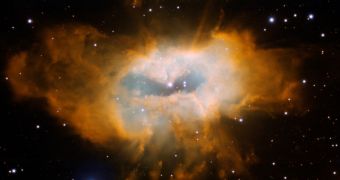The Gemini North Telescope, located in Hawaii, was recently trained on the planetary nebula Sharpless 2-71, a complex structure located in the constellation Aquila, around 3,260 light-years from Earth.
The relatively distant nebula reveals a massive swirl of gas at its core, a structure that has intrigued astronomers for several years. A bright star can be seen at the center of this nebula, but experts are not yet convinced that it is responsible for creating the structure.
A dimmer, blue star is located a bit to the right of its counterpart, and it too may have been responsible for producing the nebula. In order to image the entire nebula, experts used the Gemini Multi-Object Spectrograph on the GNT.
Planetary nebulae are improperly called thus because their glowing clouds of gas resembled a gas giant, when seen through early telescopes. Scientists now know they are made up of material released by stars that reach the end of their burning cycle, and run out of hydrogen fuel.
This causes the outer layers of their atmosphere to become detached. Radiations from the remaining stellar core then ionize the gas clouds, causing them to glow at multiple wavelengths, Space reports.
Astronomers had suspected for a long time that the bright star visible at the core of Sharpless 2-71 was responsible for creating the nebula, but the new investigation demonstrates that this may not be the case after all. The blue star is currently becoming a strong candidate as the nebula's precursor.
The conclusion was reached after astronomers from the Macquarie University, in Sidney, Australia, measured the amounts of high-energy ultraviolet light coming from the brighter star – which is actually part of a binary system – and found it to be insufficient to explain the intense glow of the nebula.
On the other hand, the blue star appears to be capable of producing the intense UV radiations required. “At the assumed distance to the nebula, the faint star has about the right brightness to be the fading remnant of the nebula’s progenitor star,” explains MU investigator David Frew, the leader of the study.
In a statement, he suggests that all three objects at the core of the nebula – the bright binary system and the blue star – may have played a role in the structure's development, even though the exact mechanism through which this was achieved has yet to be determined.
“The chaotic morphology of Sh2-71 implies that very complex processes have been involved in its formation,” says Sharpless 2-71 expert Luis Miranda, who is based at the Instituto de Astrofísica de Andalucía, in Spain.

 14 DAY TRIAL //
14 DAY TRIAL //